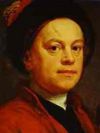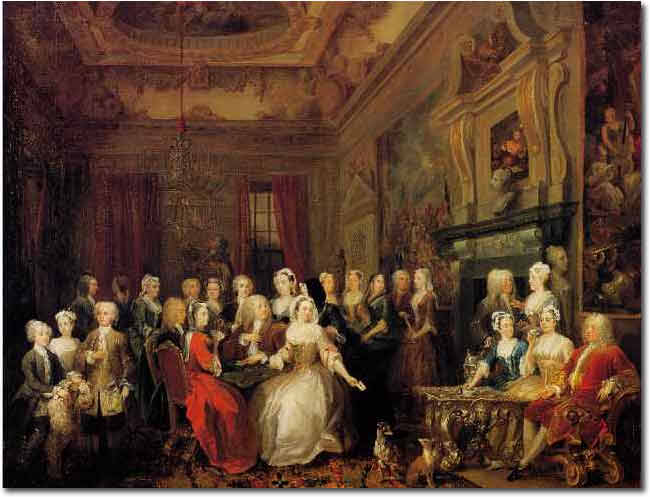Difference between revisions of "William Hogarth"
(Changed category) |
|||
| (7 intermediate revisions by 4 users not shown) | |||
| Line 1: | Line 1: | ||
[[Image:William Hogarth.jpg|right|100px]] | [[Image:William Hogarth.jpg|right|100px]] | ||
| â | '''William Hogarth''' (London, 10 November | + | '''William Hogarth''' (London, 10 November 1697 â London, 25 October 1764) English [[painter]] and engraver. He was one of the greatest innovators in [[English]] art. Hogarth was a professional rebel. He found English art sycophantic, and determined to make it independent. Instead of working for a few rich patrons, Hogarth evolved the idea of making his living out of popular engravings of his pictures. He believed that the lack of a native [[Painting Schools|school of painting]] was largely due to the fashions imposed on a credulous public by connoisseurs and critics and he waged continual war on taste and the Old Masters. ''He is best remembered for the satirical engravings that gave the name 'Hogarthian' to low-life scenes of the period.'' <ref>[http://www.questia.com/PM.qst?a=o&d=58655295 "Hogarth, Constable and Turner"]</ref><ref>[http://www.answers.com/topic/william-hogarth Answers.com]</ref> |
<blockquote> | <blockquote> | ||
| â | William Hogarth is unquestionably one of the greatest English artists and a man of remarkably individual character and thought. He is the great innovator in English art. On one hand, he was the first to paint themes from [[William Shakespeare|Shakespeare]], [[John Milton| Milton]] and the theater, and the founder of a wholly original genre of moral history, which was long known as Hogarthian. On the other, he investigated the [[Aesthetics|aesthetic]] principles of his art, which resulted in his book âThe Analysis of Beautyâ(1753). [http://www.abcgallery.com/H/hogarth/hogarthbio.html] | + | William Hogarth is unquestionably one of the greatest English artists and a man of remarkably individual character and thought. He is the great innovator in English art. On one hand, he was the first to paint themes from [[William Shakespeare|Shakespeare]], [[John Milton|Milton]] and the theater, and the founder of a wholly original genre of moral history, which was long known as Hogarthian. On the other, he investigated the [[Aesthetics|aesthetic]] principles of his art, which resulted in his book âThe Analysis of Beautyâ(1753). [http://www.abcgallery.com/H/hogarth/hogarthbio.html] |
</blockquote> | </blockquote> | ||
| Line 12: | Line 12: | ||
== See also == | == See also == | ||
| + | [[Image:Hogarth Falstaff Examining His Recruits.JPG|thumb|Falstaff Examining His Recruits]] | ||
*[[English Painting]] | *[[English Painting]] | ||
*[[English Painting Masterpieces]] | *[[English Painting Masterpieces]] | ||
*[[Painting Masterpieces]] | *[[Painting Masterpieces]] | ||
*[[William Turner]] | *[[William Turner]] | ||
| + | *[[Portrait]] | ||
| + | {{Clear}} | ||
== External links == | == External links == | ||
| â | + | [[Image:Hogarth Sigismonda.JPG|thumb|Sigismonda]] | |
| + | *[http://www.abcgallery.com/H/hogarth/hogarth.html Hogarth at Olga's Gallery] | ||
*[http://www.questia.com/PM.qst?a=o&d=58655295 "Hogarth, Constable and Turner"] - appeared in "Masterpieces of English Painting" by Hans Huth | *[http://www.questia.com/PM.qst?a=o&d=58655295 "Hogarth, Constable and Turner"] - appeared in "Masterpieces of English Painting" by Hans Huth | ||
*[http://www.nmm.ac.uk/mag/pages/mnuInDepth/Biography.cfm?biog=195 William Hogarth] | *[http://www.nmm.ac.uk/mag/pages/mnuInDepth/Biography.cfm?biog=195 William Hogarth] | ||
| + | {{Clear}} | ||
| + | |||
| + | == References == | ||
| + | <references/> | ||
{{DEFAULTSORT:Hogarth, William}} | {{DEFAULTSORT:Hogarth, William}} | ||
| â | [[Category:Painters]] | + | [[Category:English Painters]] |
Latest revision as of 22:02, May 12, 2017
William Hogarth (London, 10 November 1697 â London, 25 October 1764) English painter and engraver. He was one of the greatest innovators in English art. Hogarth was a professional rebel. He found English art sycophantic, and determined to make it independent. Instead of working for a few rich patrons, Hogarth evolved the idea of making his living out of popular engravings of his pictures. He believed that the lack of a native school of painting was largely due to the fashions imposed on a credulous public by connoisseurs and critics and he waged continual war on taste and the Old Masters. He is best remembered for the satirical engravings that gave the name 'Hogarthian' to low-life scenes of the period. [1][2]
William Hogarth is unquestionably one of the greatest English artists and a man of remarkably individual character and thought. He is the great innovator in English art. On one hand, he was the first to paint themes from Shakespeare, Milton and the theater, and the founder of a wholly original genre of moral history, which was long known as Hogarthian. On the other, he investigated the aesthetic principles of his art, which resulted in his book âThe Analysis of Beautyâ(1753). [1]
Wanstead Assembly at Wanstead House.
See also
External links
- Hogarth at Olga's Gallery
- "Hogarth, Constable and Turner" - appeared in "Masterpieces of English Painting" by Hans Huth
- William Hogarth



